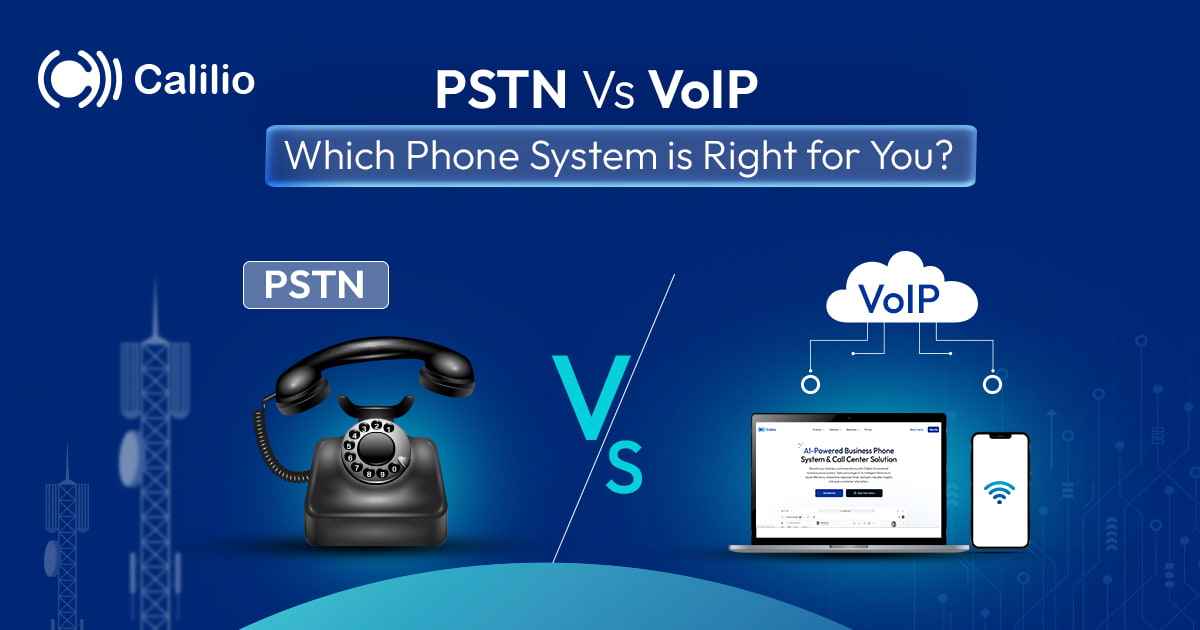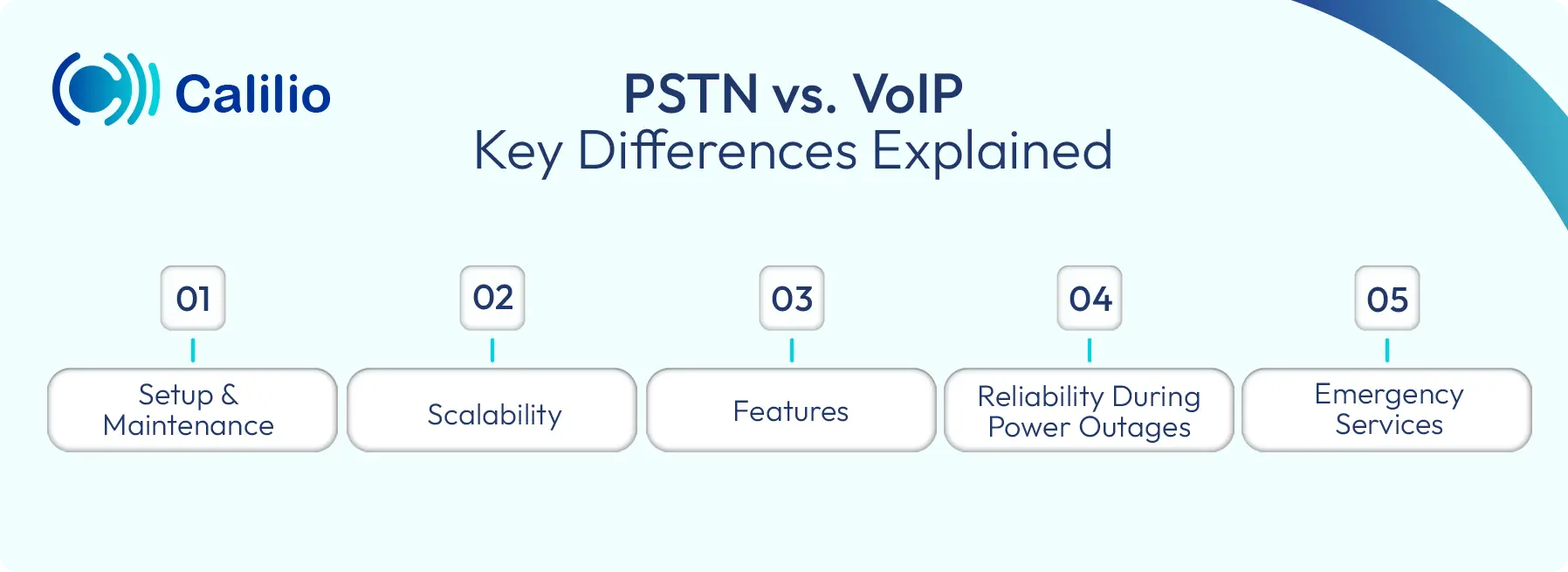PSTN vs. VoIP: Key Differences, Pros & Cons for Your Business

Choosing the right phone system is a vital decision for any business looking to stay connected and efficient. The two primary options available are PSTN (Public Switched Telephone Network) and VoIP (Voice over Internet Protocol).
While both systems handle voice communication, they operate on very different technologies and offer distinct advantages.
In this guide, we’ll break down their use cases, pros and cons, and differences to help you choose the phone system that best meets your business needs.
Key Highlights:
VoIP allows users to make and receive calls from anywhere with an internet connection, while PSTN is limited to physical line installations.
VoIP is more cost-effective and scalable than PSTN, making it ideal for startups, remote teams, and growing businesses seeking flexible and modern communication tools.
VoIP offers features such as video calls, voicemail-to-email, and call forwarding, while PSTN provides consistent voice quality and reliable access to emergency calls.
PSTN Overview
PSTN (Public Switched Telephone Network) is the traditional telephone system that has been used for decades to connect voice calls. It transmits analog voice signals over a dedicated circuit using copper wires, switches, and phone lines.
It is commonly used for standard home phones, business lines, emergency services, and fax machines.
Features of PSTN
- Call Waiting
- Caller ID
- Call Hold
- Number Portability
- Three-Way Calling
PSTN Advantages and Drawbacks
Advantages:
- Reliable Connection: PSTN offers a clear and reliable phone connection by utilizing a dedicated private line for each call, which helps minimize call drops and interruptions.
- Emergency Services Integration: PSTN is tightly integrated with emergency services, allowing accurate location tracking and faster response during emergencies.
- No internet dependency: PSTN does not require an internet connection to function, which makes it ideal for areas with limited or poor internet infrastructure.
Drawbacks:
- Higher Costs: PSTN systems often come with higher installation and call costs due to the requirement for physical infrastructure and ongoing maintenance.
- Outdated Technology: PSTN relies on traditional systems that struggle to handle the complexities of advanced communication.
- Scalability Limitations: Expanding a PSTN setup involves installing additional hardware and wiring, making it a slow, inflexible, and often costly process for businesses that are growing.
- Lack of Flexibility: PSTN systems are tied to fixed locations, making it difficult to support remote work or mobile communication.
VoIP Overview
Voice over Internet Protocol (VoIP) is a technology that enables you to make voice and video calls over the internet. It operates by using a router connected to the internet, with a handset or device linked to it for making and receiving calls.
VoIP also enables users to place calls from multiple devices, including computers, smartphones, and dedicated VoIP phones. Business phone providers commonly adopt VoIP technology to offer telephone services without requiring customers to install or maintain physical phone lines and hardware.
Features of VoIP
- Video Calling and Conferencing
- Voicemail to Email
- Caller ID
- Call Blocking
- Call Queuing
- Virtual Phone Numbers (DIDs)
- Call Recording
- Interactive Voice Response (IVR)
VoIP Advantages and Drawbacks
Advantages:
- Lower Costs: VoIP significantly reduces phone expenses by using the internet to route calls instead of phone lines. It is beneficial for long-distance and international calls, which are often much more expensive on regular telephone networks.
- Scalability: VoIP systems are highly scalable, enabling businesses to easily add or remove users without requiring the installation of new hardware.
- Unified Communications: VoIP often combines voice calls, video conferencing, instant messaging, and other collaboration tools into a single platform, enhancing team communication and collaboration to improve overall productivity.
- Integration: VoIP smoothly integrates with business applications, including CRM, email, and calendars, to enhance workflow and productivity.
Drawbacks:
- Technical Complexity: Setting up and troubleshooting VoIP systems can require technical knowledge and expertise, which might be challenging for small businesses or individuals without dedicated IT support.
- Variable Call Quality: Call clarity can fluctuate due to variations in internet bandwidth and network traffic, potentially impacting call quality.
- Power Outages: VoIP systems rely on powered devices, such as routers and modems. During a power outage, phone service may be disrupted unless a backup power supply, such as a UPS or generator, is available.
- Security Risks: Since VoIP utilizes the internet, it’s vulnerable to threats such as hacking, DDoS attacks, or eavesdropping. If the system is not well protected with encryption, firewalls, and access controls, the vulnerabilities can lead to unauthorized access and data breaches.
Upgrade to Calilio’s VoIP Solution for Affordable, Flexible & Feature-Rich Communication.
PSTN vs. VoIP: Key Differences Explained
While both PSTN and VoIP provide voice communication services, they differ in terms of technology, infrastructure, cost, features, and scalability.

- Setup and Maintenance: PSTN requires physical installation and regular maintenance of telephone lines and switches. Meanwhile, a VoIP setup is mostly software-based and easier to maintain remotely.
- Scalability: PSTN requires physical installation and upgrades to the existing telephone infrastructure, which can be time-consuming and costly. In contrast, VoIP systems provide easy and quick scalability, enabling businesses to add or remove users and features without requiring significant hardware changes.
- Features: PSTN offers basic voice calling features, including call waiting, call forwarding, and caller ID, with limited flexibility and customization. On the other hand, VoIP offers advanced features such as video conferencing, voicemail-to-email, call forwarding, auto-attendants, and integration with CRM or business apps.
- Reliability During Power Outages: PSTN can remain operational during power outages, as it uses its power from the telephone exchange. In contrast, VoIP relies on the internet and electrical power, so it may fail if power connections are disrupted.
- Emergency Services: PSTN automatically provides location information to emergency services, making it easier to locate callers. However, VoIP may require additional setup to provide accurate location data in emergencies.
PSTN vs. VoIP – Quick Comparison Overview
Criteria PSTN (Public Switched Telephone Network) VoIP (Voice over Internet Protocol) Technology Infrastructure Cost Maintenance Call Quality Features ScalabilityCircuit-switched technology with dedicated voice lines Packet-switched technology that sends voice data over the internet Uses traditional copper wires and physical telephone lines Operates over internet connections using devices like computers, smartphones, VoIP phones, and tablets Typically higher due to hardware, line rental, and long-distance fees Lower monthly costs; minimal fees for local and international calls Requires on-site maintenance for cables, hardware, and telephone exchange systems Easier to maintain and update remotely via software Consistent and reliable due to dedicated lines Depends on the internet speed and quality Basic features like voicemail and caller ID Advanced features like video calls, voicemail-to-email, and call recording Difficult and expensive to expand (new lines needed) Highly scalable; users can be added or removed via software without new hardware
Which is the Better Choice Between PSTN and VoIP?
The choice between PSTN and VoIP depends on your business’s size, goals, and communication needs.
Pick PSTN if:
- Your business already relies on legacy phone systems.
- You require uninterrupted service even during power outages or internet failures.
- You have strict security or compliance requirements.
- You live in an area with limited or unstable internet access.
- You don't need remote or mobile flexibility.
Pick VoIP if:
- You want to save on call costs, especially for international or long-distance calls.
- You plan to scale your business, add users easily, or operate remotely.
- You have reliable internet and backup power solutions.
- You want built-in features like call recording, analytics, or integrations.
Conclusion
PSTN and VoIP both provide voice communication, but they work in very different ways. PSTN utilizes landline-based systems and is known for its stable and reliable call quality, making it ideal for users who prefer a traditional phone setup. On the other hand, VoIP is a great option for businesses and users who rely on internet-based tools.
Your Phone System Just Got Cheaper
Virtual numbers from just $2/month
Call rates starting as low as $0.016/min
The most cost-effective VoIP phone system for businesses
Powered by advanced AI telephony features
Compare low-cost business phone systems
Frequently Asked Questions
Can VoIP fully replace PSTN?
Yes, VoIP can fully replace PSTN in most cases. VoIP offers more features, lower costs, and greater flexibility. However, PSTN may still be preferred in areas with poor internet or frequent power outages.
Which offers better call quality, PSTN or VoIP?
Can I keep my existing phone number when switching to a VoIP service?

Still have questions?
Can’t find the answer you’re looking for? Please chat with our friendly team.
Stay in the loop
Get the latest call insights, trends, and updates delivered straight to your inbox.
By subscribing, you agree to receive updates from Calilio.
You can unsubscribe anytime.
Phone numbers
Get International Phone Numbers
Singapore
|Australia
|New Zealand